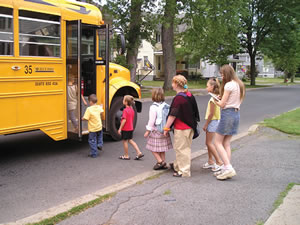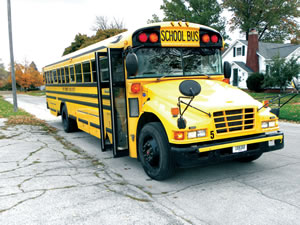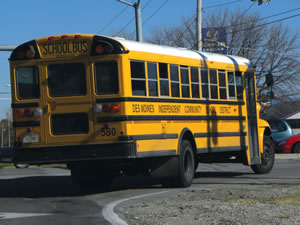School-Bus-Safe
- By Michael Fickes
- 04/01/16

PHOTOS MADE AVAILABLE BY PTSI
What if everyone road a school bus
when traveling to and from school — or work, shopping,
sightseeing or going anywhere for that matter. Of course,
such a sea change is impossible, but if it could and did happen, it would
produce a dramatic decline in traffic accidents, injuries and fatalities.
School buses may, in fact, be the safest form of transportation
on U.S. highways.
Think about these statistics collected by the National Highway
Transportation Safety Administration (NHTSA):
- From 2004 to 2013, there were 340,039 fatal vehicle crashes on
the road. Of those, 1,214 involved a school transportation vehicle.
- Over the same period, 1,344 people died in crashes involving a
school transportation vehicle. Students and other traveling inside a
school vehicle accounted for just eight percent of those fatalities.
- 71 percent of the people who died were traveling in the other
vehicles involved in the crashes.
“School bus transportation is incredibly
safe compared to other ways kids get
to school,” says Charlie Hood, executive
director of the National Association of State
Directors of Pupil Transportation Services
(NASDPTS).
In addition to safety, school buses also
provide learning benefits, environmental
benefits and community benefits.

PHOTOS MADE AVAILABLE BY PTSI
Driven to be Safe. The yellow school bus ranks as one of the safest, most trusted symbols on the
nation’s landscape. That trust is well deserved. A school bus is a safe, environmentally friendly way for
students to get to and from school, every school day of the year.
Safe Drivers and Safe Buses
School bus safety begins with recruiting
and training safe drivers and ends with designing
and manufacturing safe buses. The
school transportation industry has become
skilled at both tasks.
“Driver recruitment and retention is
one of the main issues school districts
are dealing with today,” says Kathleen
Furneaux, executive director of the Pupil
Transportation Safety Institute.
It is a problem the cycles in lockstep
with the economy, continues Furneaux. In
a healthy, expanding economy, such as the
one we have today, drivers are hard to find.
People with the abilities and talents important
to driving a school bus are typically
employed in a growing economy.
The reverse is true in a recessionary
economy. There are plenty of drivers to be
found.
“Pair the recruitment difficulties with
the fact that driver compensation probably
isn’t what it should be — the industry
pays wages ranging from $12 to $25 per
hour,” Furneaux says. “Higher wage areas,
of course, have fewer problems filling drivers’ seats.”
Once drivers are recruited, they
undergo stringent training. Commercial
vehicle drivers must earn a commercial
driver’s license (CDL), which requires
much more training than the regular
driver’s license the rest of us carry.
School bus drivers must earn a CDL with
what is called a school bus endorsement,
which requires training beyond the requirements
of a regular CDL. (See related
story, Page 37)
Then comes safe school bus design and
construction. “Since 1997, all new school
buses have been required to have a system
of passenger crash protection,” says Hood.
In a school bus, this system is called
compartmentalization, which mandates
special designs in the interior, continues
Hood. For example, the seats have high
backs and thick padding designed to protect
a child thrown forward by an impact.
“School bus design includes major
structure features focused on safety,”
adds Furneaux. “For example, school
buses have break-away bodies. In a severe
collision, the passenger compartment,
the box that sits on the frame, detaches.
That’s important because if the frame
of the bus crumples in an accident an
attached passenger compartment would
crumple as well.
Statistics prove the effectiveness of
school bus safety features. About 26 million
children ride school buses every day
of the school year, and crashes cause only
four or five fatalities.
Industry observers often point to an accident
that occurred in Huntsville, Ala., in
Nov. 2006, to substantiate how safe buses
are. A small car bumped a school bus while
trying to pass on an Interstate overpass.
The impact nudged the bus to the right and
the right front tire ran up the protective
sidewall and over the edge, plummeting
nose first 40 feet.
Forty students were on the bus. Four
were killed. Twenty-three students were
injured but recovered. Thirteen students
and the driver escaped without injury.
Experts say that only the special design and construction of a school bus could
enable 36 of 40 individuals to survive such
a devastating crash.

PHOTOS MADE AVAILABLE BY PTSI
Beyond Safety: Learning Benefits
Industry observers contend that school
buses also help students learn.
The American School Bus Council
(ASBC) website devotes a full page to the
learning benefits provided by school buses.
According to the website, when a student
boards a bus, he or she will end up in
school and not the local video game arcade.
According to the FBI, this theory is
credible. FBI statistics say that 20 percent
of truants attribute their absence from
school to having missed the bus.
Without the bus, some students would
end up walking to school. While walking a
reasonable distance can invigorate, walking
too far will make students tired and
unable to perform at school. A school bus
ride ensures that students will get to school
ready and able to learn.
Environmental Benefits
Mass transit systems — trains and
subways as well as buses — take smaller
vehicles off the roads.
The ASBC website asserts that the
school bus industry is the largest form of
mass transit in the United States.
Really?
Yes. Every day, 480,000 school buses
carry 25 million students — more than
half of all pre-K through 12 students in the
country — to and from school.
The ASBC site goes on to say that every
school bus takes approximately 36 cars
off the road. In 2010, ASBC calculated
that 480,000 school buses handled student
transportation that took more than
17 million cars off the road, saved 2.3
billion gallons of fuel, which would have
cost $6 billion.
Fuel savings at that level also eliminates
substantial amounts of damaging emissions,
thereby helping to reduce environmental
pollution.
The yellow school bus ranks as one
of the safest, most trusted symbols on
the nation’s landscape. That trust is well
deserved. A school bus is a safe, environmentally
friendly way for students to get
to and from school, every school day of
the year.
This article originally appeared in the issue of .